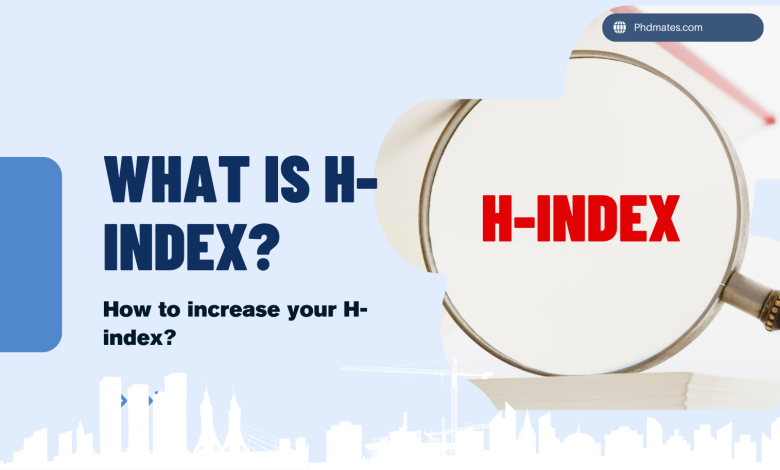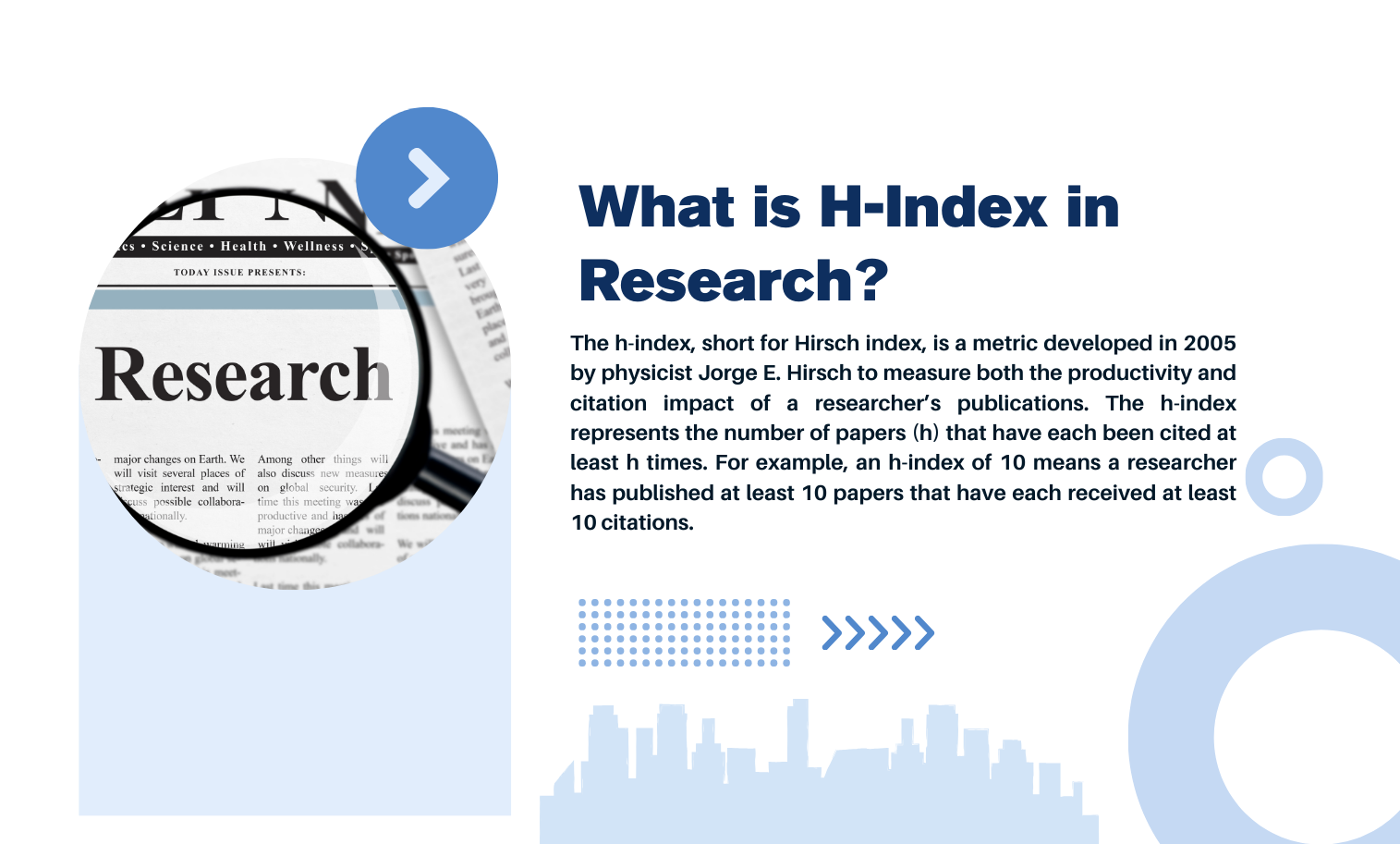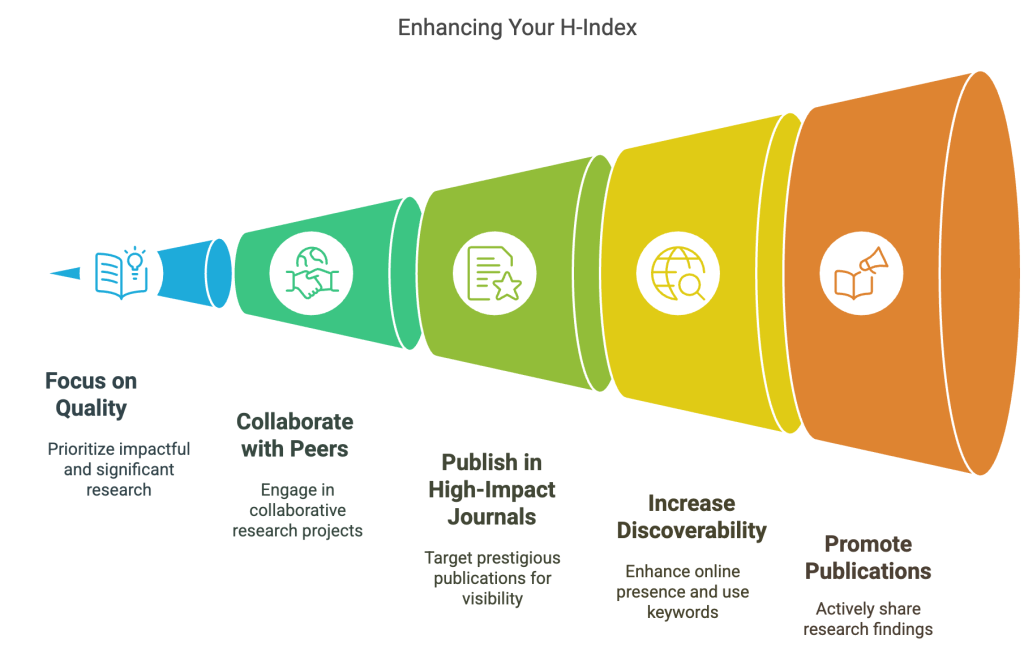What is H-Index in Research? What is a Good H-Index?

The h-index or Hirsch index has become one of the most important metrics in academia for measuring a researcher’s productivity, quality and citation impact. Unlike simple citation counts or publication numbers, the h-index balances both quantity and quality, providing a more comprehensive picture of scholarly influence. This particular guide will explains what the h-index is, how it’s calculated, its significance in research evaluation, and how researchers can improve their h-index scores.
Contents
- 1 What Is the H-Index?
- 2 How to Calculate H-Index
- 3 The Significance of H-Index in Academia
- 4 What Is a Good H-Index?
- 5 Highest H-Index Records
- 6 H-index vs i10-Index of Google Scholar
- 7 How to Improve Your H-Index
- 8 H-Index Across Different Research Databases
- 9 Limitations and Criticisms of the H-Index
- 10 H-Index in Academic Hiring and Promotion
- 11 Summary
What Is the H-Index?

The h-index, short for Hirsch index, is a metric developed in 2005 by physicist Jorge E. Hirsch to measure both the productivity and citation impact of a researcher’s publications. The h-index represents the number of papers (h) that have each been cited at least h times. For example, an h-index of 10 means a researcher has published at least 10 papers that have each received at least 10 citations.
This single number attempts to capture both the breadth and depth of a researcher’s work, making it a popular tool for evaluating academic performance across different fields.
Read: How to Write Research Proposal: Free Download Format
H-Index Example:
Dr. John has published 15 research papers throughout his career. When arranged by citation count:
- 5 papers have been cited 20+ times each
- 3 papers have been cited 15 times each
- 2 papers have been cited 8 times each
- 5 papers have been cited 4 or fewer times each
His h-index would be 8, as he has 8 papers that have been cited at least 8 times each.
How to Calculate H-Index
The h-index merges two important aspects of research output: (a) the number of publications (quantity) and (b) the number of citations each research publication receives (quality or impact). Unlike metrics that only measure one dimension, the h-index requires researchers to maintain both consistent publication output and meaningful impact through citations.
How to calculate your h-index, follow these steps:
- List all your publications in descending order based on citation count
- Number the publications from 1 to n
- Find the point where the publication number equals or exceeds its citation count
- The highest number where the publication rank is less than or equal to the citation count is your h-index
Most researchers don’t need to calculate this manually, as academic databases like Google Scholar, Web of Science, and Scopus automatically calculate h-indices for authors.
| Publication Rank | Publication Title | Citation Count |
|---|---|---|
| 1 | Paper A | 45 |
| 2 | Paper B | 32 |
| 3 | Paper C | 20 |
| 4 | Paper D | 15 |
| 5 | Paper E | 10 |
| 6 | Paper F | 8 |
| 7 | Paper G | 7 |
| 8 | Paper H | 4 |
| 9 | Paper I | 2 |
| 10 | Paper J | 1 |
In this example, the h-index is 7, as there are 7 papers with at least 7 citations each.
The Significance of H-Index in Academia
The h-index has gained substantial traction in academic circles since its introduction. Universities, funding agencies, and hiring committees frequently use it to evaluate researchers for performance appraisals, promotion, tenure, and grant allocation. Its popularity stems from several key advantages it offers over other metrics.
The h-index provides a more balanced assessment than simple citation counts or publication numbers alone. For researchers it is necessary to perform constantly and in increasing manner, this is where h-index comes into play. It rewards consistent performance rather than one-hit wonders, as researchers must regularly produce impactful work to increase their h-index. This makes it harder to artificially inflate through self-citation or publication in predatory journals.
For early-career researchers, the h-index offers a meaningful way to track academic progress. As careers develop, researchers can watch their h-index grow, reflecting their expanding influence in their field. For established scholars, a high h-index often correlates with other recognition forms like prestigious awards or fellowships.
What Is a Good H-Index?
Determining what constitutes a “good” h-index depends heavily on your field, career stage, and research focus. Different disciplines have vastly different citation patterns, making direct comparisons between fields problematic. For instance, biomedical researchers typically accumulate citations more rapidly than mathematicians or historians.
As a general benchmark, h-indices can be roughly interpreted as follows for established researchers (15+ years in academia):
| H-Index Range | Approximate Standing |
|---|---|
| 1-5 | Early career researcher or limited publication record |
| 6-10 | Mid-level assistant professor or emerging researcher |
| 11-20 | Associate professor level, established researcher |
| 21-30 | Full professor, highly respected researcher |
| 30+ | Distinguished researcher, leader in the field |
| 60+ | Exceptional researcher, often globally recognized |
For context, Nobel Prize winners typically have h-indices above 40, and often above 60. However, these are exceptional cases and not reasonable targets for most academics. The most valuable comparison is often against peers in your specific subfield at similar career stages.
Highest H-Index Records
Some researchers have achieved remarkably high h-indices, demonstrating extraordinary impact in their fields. While these exceptional cases shouldn’t be considered typical benchmarks, they illustrate the upper limits of academic influence as measured by this metric.
According to various sources, some of the highest recorded h-indices include:
| Researcher | Field | H-Index | Total Citations |
|---|---|---|---|
| Michel Foucault | Philosophy | 311 | 1421195 |
| Sigmund Freud | Psychology | 299 | 724873 |
| Edward Witten | Physics | 213 | 262889 |
| Bert Vogelstein | Medicine | 296 | 521183 |
| Noam Chomsky | Linguistics | 199 | 518705 |
| Robert Langer | Bioengineering | 330 | 446774 |
As seen above these h-indices are very extraordinary. These are representative of careers spanning over several decades and could only be achieved with groundbreaking contributions that have fundamentally shaped their field. For most researchers, such numbers remain aspirational rather than realistic goals.
H-index vs i10-Index of Google Scholar
Despite its popularity, the h-index has recognized limitations. To address these shortcomings, researchers have developed several variations and complementary metrics that provide additional perspectives on scholarly impact.
The g-index gives more weight to highly-cited papers, allowing exceptional publications to contribute more to the overall score. This addresses a key criticism of the h-index, which treats a paper with 1,000 citations the same as one with just the minimum citations needed to be counted.
The m-index divides the h-index by the number of years since the researcher’s first publication, creating a time-normalized measure that helps compare scholars at different career stages. This is particularly useful when evaluating early-career researchers against established colleagues.
The i10-index, used by Google Scholar, counts the number of publications with at least 10 citations. While simpler than the h-index, it offers a complementary view of research impact focused on works that have achieved a meaningful citation threshold.
H-Index Variations Comparison
Consider two researchers with the same h-index of 15:
- Researcher A has several papers with 100+ citations (high g-index)
- Researcher B has no papers with more than 25 citations (lower g-index)
- Researcher A has been publishing for 20 years (m-index = 0.75)
- Researcher B has been publishing for 10 years (m-index = 1.5)
While their h-indices are identical, other metrics reveal different impact patterns.
How to Improve Your H-Index

For researchers looking to increase their h-index, several strategic approaches can help. These strategies focus on both increasing publication count and maximizing the impact and visibility of each publication.
First, focus on quality over quantity. While the h-index rewards productivity, papers with minimal impact won’t contribute to your score. Prioritize thorough, significant research that addresses important questions in your field rather than rushing to publish incremental findings.
Collaboration can significantly boost your h-index. Working with established researchers and international teams typically leads to papers that receive more citations. These collaborations also expand your network, increasing the visibility of your work and creating opportunities for future projects.
Publishing in high-impact journals increases the likelihood that your work will be seen and cited. While journal impact factor isn’t everything, papers in prestigious publications generally receive more attention from the academic community.
Make your research more discoverable by using consistent name formats, claiming your publications in databases like ORCID, Google Scholar, and ResearchGate, and ensuring your papers contain appropriate keywords. Consider using preprint servers to share your work earlier in the publication process.
Actively promote your publications through academic social networks, conferences, and social media. Many researchers now share their findings through threads on platforms like Twitter/X, helping their work reach broader audiences.
H-Index Across Different Research Databases
Your h-index can vary significantly depending on which database you consult. This variation occurs because different platforms index different journals and have varying methods for counting citations.
Google Scholar typically produces the highest h-index values because it has the broadest coverage, including conference papers, books, and non-peer-reviewed materials. However, this inclusiveness also means it may count citations from less rigorous sources.
Web of Science tends to generate lower h-indices because it has stricter inclusion criteria, focusing primarily on established, peer-reviewed journals. Many researchers consider WoS citations more prestigious, though its coverage has historical gaps in certain fields.
Scopus offers a middle ground with broader coverage than Web of Science but more selectivity than Google Scholar. Its citation counts and resulting h-indices usually fall between the other two databases.
| Database | Coverage | Typical H-Index Impact |
|---|---|---|
| Google Scholar | Very broad (includes preprints, books, conferences) | Highest |
| Scopus | Moderate (peer-reviewed journals and selected conferences) | Medium |
| Web of Science | Selective (primarily established journals) | Lowest |
When reporting your h-index, it’s best practice to specify which database provided the calculation. Many researchers include all three figures on their CVs to provide a more complete picture of their impact.
Limitations and Criticisms of the H-Index
Despite its widespread adoption, the h-index has several recognized limitations that researchers and evaluators should consider. Understanding these shortcomings helps provide context when using the metric for evaluation purposes.
Field dependency is perhaps the biggest issue with the h-index. Citation patterns vary dramatically across disciplines, making direct comparisons between fields inappropriate. A physicist might easily achieve an h-index of 40, while an equally accomplished historian might peak at 15-20 due to different citation cultures.
The h-index disadvantages early-career researchers by design. Since building citations takes time, younger scholars inevitably have lower h-indices regardless of the quality of their work. This is why alternative metrics like the m-index were developed.
Self-citations can artificially inflate the h-index, though their impact diminishes as a researcher’s citation count grows. Some databases now offer h-index calculations that exclude self-citations to address this concern.
The h-index cannot decrease over time, which means it doesn’t reflect whether a researcher’s work remains relevant. A scientist could stop publishing entirely but maintain their h-index indefinitely, unlike metrics that measure recent impact.
Book-based disciplines like humanities often see lower h-indices because books and book chapters typically receive fewer citations than journal articles, despite potentially having greater scholarly impact.
H-Index in Academic Hiring and Promotion
The role of the h-index in academic career advancement varies significantly across institutions and disciplines. Understanding how this metric factors into evaluation processes can help researchers navigate career development more effectively.
Many universities consider the h-index during hiring, tenure, and promotion decisions, particularly in STEM fields. However, it’s rarely used as a standalone metric but rather as one component of a broader evaluation that includes teaching, service, and qualitative assessments of research impact.
Granting agencies increasingly look at h-indices when evaluating funding applications. A strong publication record with corresponding impact can strengthen a researcher’s case for financial support, especially for larger grants with competitive applicant pools.
The weight given to the h-index varies dramatically by discipline. In fields like biomedicine, physics, and computer science, it often plays a significant role in evaluation. In humanities and some social sciences, other factors like books published, exhibit curation, or public engagement might carry more weight.
Researchers should familiarize themselves with the evaluation criteria specific to their institutions and fields. While improving your h-index is generally beneficial, balancing this goal with other professional development areas ensures well-rounded career advancement.
Summary
The h-index has transformed how academic impact is measured, providing a simple yet informative metric that balances productivity and influence. While imperfect, it continues to be one of the most widely used tools for evaluating scholarly output.
As academia evolves, so too will impact metrics. New measures that account for open science practices, dataset creation, code development, and other non-traditional outputs are gaining traction. Alternative metrics (“altmetrics”) that track social media mentions, news coverage, and policy documents citing research are also becoming more common.
The most effective approach for researchers is to maintain awareness of how their work is measured while focusing primarily on conducting meaningful, rigorous research. Understanding the h-index and its implications helps navigate career development, but the ultimate goal remains advancing knowledge in your field.
For institutions and evaluation committees, the h-index should remain one tool among many in assessing scholarly contributions. Combining quantitative metrics with qualitative evaluation ensures a more complete and fair assessment of academic impact.
As research practices and dissemination methods continue to evolve, the metrics we use to evaluate scholarly impact will undoubtedly adapt as well. The h-index has proven remarkably durable, but complementary measures will likely play increasingly important roles in the comprehensive evaluation of academic contributions.
